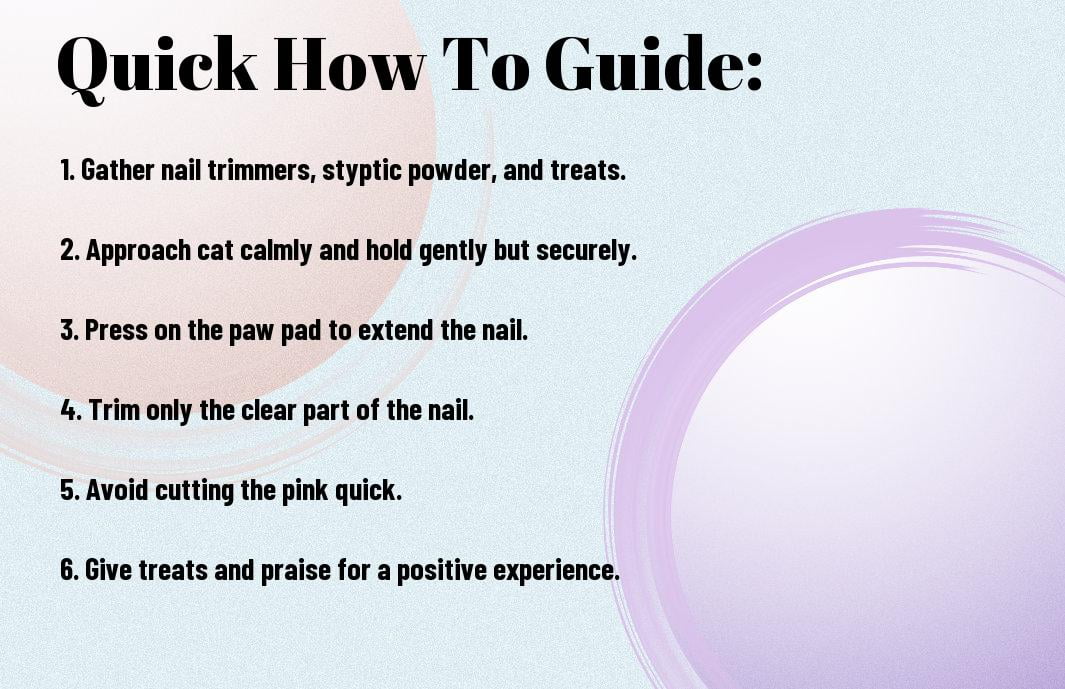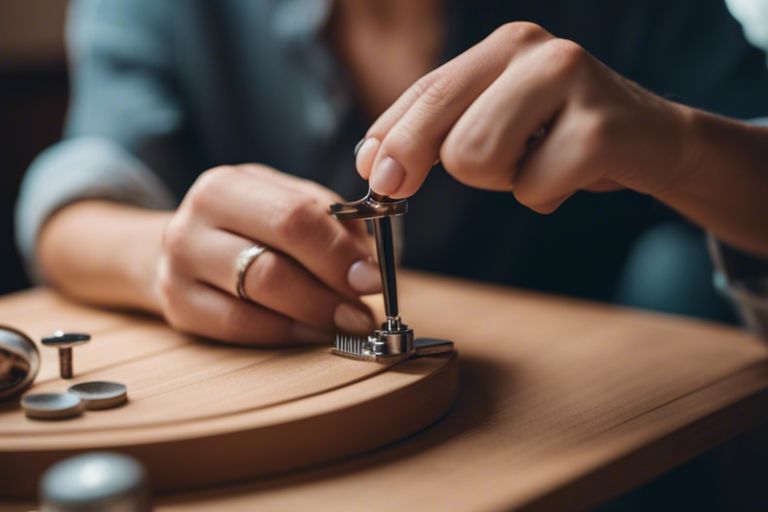Many cat owners may find themselves hesitant to trim their feline friend’s nails at home, but with the right knowledge and technique, it can be a simple and stress-free task. Trimming your cat’s nails regularly is necessary for their health and well-being, as it helps prevent painful ingrown nails and damage to furniture and skin. In this guide, we will walk you through the steps to safely trim your cat’s nails at home, ensuring a positive experience for both you and your furry companion.

Preparing to Trim Your Cat’s Nails
Factors to Consider Before You Start
Even though trimming your cat’s nails is a common grooming practice, it is crucial to consider a few factors before beginning the process. First, ensure that your cat is calm and relaxed before attempting to trim their nails. It may be helpful to pet them and give them some treats to create a positive association with nail trimming. Additionally, make sure that you have the correct tools to avoid causing any discomfort or harm to your pet.
- Choose a time when your cat is typically more relaxed, such as after a meal or playtime.
- Have styptic powder or a clotting agent on hand in case you accidentally cut the quick, causing bleeding.
Knowing these factors will help make the nail trimming experience more pleasant for both you and your feline companion.
Gathering the Necessary Tools
Now that you have considered the factors for trimming your cat’s nails, it is necessary to gather the appropriate tools for the task. Necessary tools include a pair of cat nail clippers or nail scissors specifically designed for cats, styptic powder or a clotting agent, and treats to reward your cat for good behavior during the process.
Before you begin trimming, it is crucial to ensure that your tools are clean and sharp to make the process efficient and less stressful for your cat. Dull clippers can cause splintering or crushing of the nail, which may lead to discomfort for your cat.
How to Acclimate Your Cat to Nail Trimming
Tips for Getting Your Cat Comfortable
Little by little, you can help your cat get more comfortable with the idea of nail trimming. Start by petting and handling your cat’s paws gently to get them used to the sensation. Offer treats and praise during these interactions to create a positive association.
- Use a scratching post to encourage healthy scratching behavior.
- Introduce the nail clippers gradually, allowing your cat to sniff and inspect them.
Though it may take some time, patience is key in helping your cat feel at ease with nail trimming.
Building a Positive Association with Nail Trimming
Some cats may be anxious or resistant to nail trimming due to past negative experiences. An important step in acclimating your cat to nail trimming is to build a positive association with the process. This can be achieved through gentle handling, praise, and rewards.
An effective way to create a positive association is to pair nail trimming sessions with activities or treats that your cat enjoys. By making nail trimming a part of a pleasant routine, your cat will be more likely to cooperate.
This approach can help reduce stress and fear associated with nail trims, making the experience more pleasant for both you and your feline friend.

The Trimming Process Explained
Identifying the Quick
Not all cat owners may be familiar with the term “quick,” but it is an vital part of the nail trimming process. The quick is a vein that runs into the nail and appears as a pink area within the nail. Cutting this sensitive part can cause pain and bleeding.
On light-colored nails, the quick is easily visible. However, on dark nails, it may be more challenging to see. In these cases, it is best to trim small amounts of the nail at a time to avoid cutting into the quick.
How-to Guide: The Step-by-Step Approach
Trimming your cat’s nails at home can be a straightforward process if done correctly. Follow these steps for a stress-free nail trimming session.
| Step | Description |
| 1 | Choose a quiet and comfortable place for the trimming session. |
| 2 | Gently hold your cat and start by trimming one nail at a time. |
| 3 | Use cat-specific nail clippers and trim at a 45-degree angle. |
| 4 | Stop if you see the quick and only trim the sharp tip of the nails. |
It is crucial to remain calm and patient throughout the process to avoid stressing your cat or causing accidental injuries.
Safety First: Techniques for Avoiding Injury
Despite the benefits of regular nail trims for your cat, it’s crucial to prioritize safety during the process to avoid causing any harm. Proper techniques and precautions can help both you and your feline friend have a stress-free nail trimming experience.
How to Handle Your Cat’s Paws
Safety starts with how you handle your cat’s paws during the nail trimming process. Gently but firmly hold your cat’s paw in your hand, making sure not to squeeze too tightly. Be mindful of your cat’s comfort and avoid forcing a paw into an uncomfortable position, as this may cause anxiety or even lead to accidental scratching.
Precautions to Prevent Accidental Cuts
Accidental cuts and injuries can happen during nail trims, but there are precautions you can take to minimize the risk. Before starting, make sure you have good lighting and a steady hand. Use high-quality cat nail clippers that are sharp and the right size for your cat’s nails. Additionally, be cautious when trimming near the quick, the pink part of the nail that contains blood vessels and nerves, to prevent causing pain or bleeding.
Do not forget, if you do accidentally cut the quick and cause bleeding, remain calm and be prepared with styptic powder or a styptic pencil to stop the bleeding. Apply gentle pressure and reassure your cat to prevent further stress or anxiety.
Managing Difficult Behaviors
Many cat owners may experience difficulties when attempting to trim their cats’ nails at home. Cats can become anxious, scared, or resistant during nail trims, making the process challenging. However, with the right approach and techniques, you can successfully manage these difficult behaviors and ensure a safe and stress-free nail trimming experience for both you and your feline friend.
Tips for Dealing with Anxious Cats
To help calm anxious cats during nail trims, create a quiet and comfortable environment. Play soothing music, dim the lights, and offer treats or toys to distract and reward your cat. It’s imperative to stay calm and patient, as your cat can sense your emotions. Approach your cat gently and avoid sudden movements or loud noises that can startle them. Additionally, consider using calming aids such as pheromone sprays or diffusers to help reduce anxiety.
- Create a calm and quiet environment
- Use treats or toys as distractions
- Avoid sudden movements or loud noises
- Consider using calming aids like pheromone sprays
After the nail trim, reward your cat with praise and treats to reinforce positive behavior and create a positive association with the experience.
How to Proceed If Your Cat Resists
Difficult behaviors such as resistance during nail trims can be challenging to manage. If your cat resists, it’s imperative to remain patient and avoid forcing the issue. Trying to restrain or hold down a resistant cat can lead to stress and potential injury for both you and your cat. Instead, take a break and try again later or seek assistance from a professional groomer or veterinarian.
Understanding your cat’s body language and signals can also help you determine when to proceed or when to stop. Look for signs of stress such as flattened ears, dilated pupils, or an agitated tail. By recognizing these signals, you can adjust your approach and ensure a more successful nail trimming session.

Aftercare and Reward Practices
How to Treat Your Cat Post-Trimming
After trimming your cat’s nails, it is important to ensure their comfort and well-being. Any signs of bleeding can be addressed by applying gentle pressure with a clean cloth or styptic powder to stop the bleeding. If your cat appears stressed or anxious, provide a quiet and familiar environment for them to relax in. Additionally, offer their favorite treats or a comforting lap to sit on to help them feel secure after the nail-trimming process.
Positive Reinforcement Techniques
Now, when it comes to rewarding your cat after nail trimming, positive reinforcement is key. By associating the nail-trimming session with something positive, such as treats or playtime, your cat is more likely to feel comfortable and cooperative during future grooming sessions. A calm and reassuring tone of voice can also help reassure your cat and strengthen the bond between you.
Aim to reward your cat immediately after the nail-trimming session to reinforce good behavior. Consistency is key in using positive reinforcement techniques to create a positive experience for your feline friend.
Knowing When to Seek Professional Help
Your cat’s health and well-being are of utmost importance when it comes to nail trimming. While grooming your feline friend at home can be a rewarding experience, there are times when it’s necessary to seek professional help. If you notice any signs of distress or if your cat becomes extremely agitated during the nail trimming process, it’s best to consult a vet or professional groomer.
Indicators That It’s Time to Consult a Vet or Groomer
Any signs of bleeding, excessive struggling, or unusual behavior during nail trimming should be taken seriously. Additionally, if you find it challenging to trim your cat’s nails despite following proper techniques, seeking help from a professional is recommended. They have the expertise and tools to handle the situation safely and effectively, ensuring your cat’s comfort and well-being.
Alternatives to Home Nail Trimming
Trimming your cat’s nails at home may not be feasible for every pet owner. If you find it too difficult or stressful for both you and your cat, there are alternatives to consider. One option is to schedule regular nail trimming appointments with a vet or professional groomer. They have the skills and experience to trim your cat’s nails efficiently, reducing the risk of injury or stress.
Timely grooming sessions can help maintain your cat’s nail health and prevent any potential issues that may arise from neglected nails. Keep in mind, the goal is to keep your furry friend comfortable and safe, so don’t hesitate to seek professional help when needed.
Conclusion
The key to safely trimming your cat’s nails at home is to be patient, gentle, and prepared. By following the steps outlined in this guide and using the proper tools, you can help keep your cat’s nails healthy and prevent any injuries or accidents during the process. Remember to always reward your cat for their cooperation and never force them to continue if they become too stressed.
The more you practice trimming your cat’s nails, the easier it will become for both you and your furry friend. If you are unsure about trimming your cat’s nails or if your cat is particularly resistant, don’t hesitate to seek assistance from a professional groomer or veterinarian. With the right approach and a little practice, you can successfully trim your cat’s nails at home, helping to maintain their overall health and well-being.
FAQ
Q: Why is it important to trim my cat’s nails?
A: Trimming your cat’s nails is important to prevent them from becoming too long and causing discomfort or potential injury to your cat or yourself.
Q: How often should I trim my cat’s nails?
A: Cats’ nails should be trimmed every 2-4 weeks to maintain a healthy length and prevent them from getting too sharp.
Q: What tools do I need to trim my cat’s nails at home?
A: You will need a pair of pet nail trimmers, styptic powder (to stop bleeding in case you cut the quick), and treats to reward your cat for good behavior.
Q: How do I safely trim my cat’s nails?
A: To safely trim your cat’s nails, hold the paw gently but firm, trim only the tip of the nail, avoid cutting the quick (the pink part inside the nail), and praise your cat throughout the process.
Q: What should I do if my cat is resistant to nail trimming?
A: If your cat is resistant to nail trimming, start slow, desensitize them to the tools, and consider seeking help from a professional groomer or veterinarian for assistance.

















